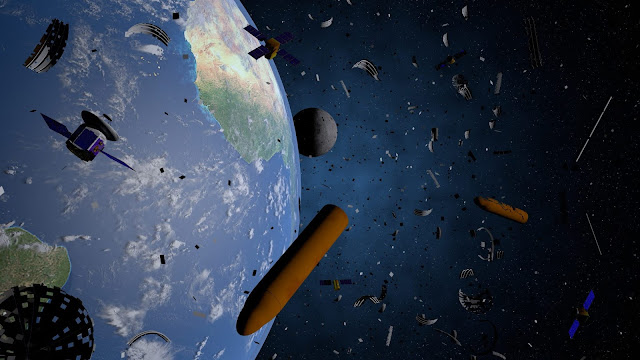Space is getting crowded with junk || Space Debris
Space debris( also know as space junk, space pollution , space waste, space trash, or space garbage) is defunct artificial objects in space-principally in Earth orbit- which no longer serve a useful function. These include derelict spacecraft - nonfunctional spacecraft and abandoned launch vehicles stages- mission-related debris, and particular numerous in Earth orbit, fragmentation debris from the breakup of derelict rocket bodies and spacecraft.
Orbital Debris and Human Spacecraft
More than 27,000 pieces of orbital debris,or"space junk," are tracked by the Department of Defense's global Space Surveillance Network(SSN) sensors. Much more debris--too small to be tracked, but large enough to threaten human spaceflight and robotic missions--exist in the near-Earth space environment. Since both the debris and spacecraft are travelling at extremely high speeds (approximately 15,000 mph in low Earth orbit), and impact of even a tiny piece of orbital debris with a spacecraft could create big problems.
Orbital debris
Space debris encompasses both natural and artificial debris.Orbital debris is any human-made object in orbit about the Earth that no longer servers as useful function.
There are approximately 23,000 pieces of debris larger than a softball orbiting the Earth. They travel at speeds up to 17,500 mph, fast enough for a relatively small piece of orbital debris to damage a satellite or a spacecraft. There are half a million pieces of debris the size of a marble or larger .04 inches (or one millimetre) and larger. There is even more smaller micrometer-sized( 0.000039 of an inch in diameter) debris.
Even tiny paint flecks can damage a spacecraft when travelling at these velocities. A number of space shuttle windows were replaced because of damage caused by material that was analyzed ans shown to be paint flecks. In fact, millimetre-sized orbital debris represents highest mission-ending risk to most robotic operating in low Earth orbit.
Data from General Catalogue of Artificial Space Objects, curated by Jonathan MdDowell, shows how payload objects-typically satellites-have entered orbit at increasing numbers in the past couple of years the sector has been booming. The number of space junk objects has been growing at an even faster rate, however.
The graph included objects listed in the database's standard and auxiliary and orders objects for the year they entered their current orbit stage-typically their launch date, but at times also their separation date if the object in question got lost at a later stage or was created by a breakup. The database lists more than 58,000 space objects from 1958 onwards, out of which around remain in orbit.




Comments
Post a Comment